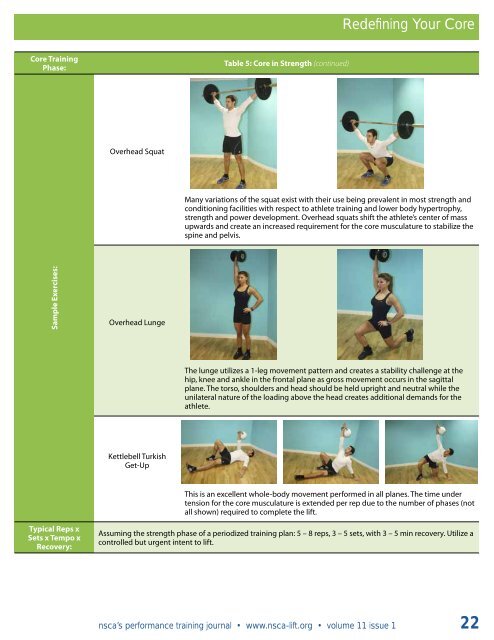NSCA's Performance Training Journal | Issue 11.1 - Premier Fitness
NSCA's Performance Training Journal | Issue 11.1 - Premier Fitness
NSCA's Performance Training Journal | Issue 11.1 - Premier Fitness
You also want an ePaper? Increase the reach of your titles
YUMPU automatically turns print PDFs into web optimized ePapers that Google loves.
Core <strong>Training</strong><br />
Phase:<br />
Sample Exercises:<br />
Typical Reps x<br />
Sets x Tempo x<br />
Recovery:<br />
Overhead Squat<br />
Overhead Lunge<br />
Kettlebell Turkish<br />
Get-Up<br />
Table 5: Core in Strength (continued)<br />
Redefi ning Your Core<br />
Many variations of the squat exist with their use being prevalent in most strength and<br />
conditioning facilities with respect to athlete training and lower body hypertrophy,<br />
strength and power development. Overhead squats shift the athlete’s center of mass<br />
upwards and create an increased requirement for the core musculature to stabilize the<br />
spine and pelvis.<br />
The lunge utilizes a 1-leg movement pattern and creates a stability challenge at the<br />
hip, knee and ankle in the frontal plane as gross movement occurs in the sagittal<br />
plane. The torso, shoulders and head should be held upright and neutral while the<br />
unilateral nature of the loading above the head creates additional demands for the<br />
athlete.<br />
This is an excellent whole-body movement performed in all planes. The time under<br />
tension for the core musculature is extended per rep due to the number of phases (not<br />
all shown) required to complete the lift.<br />
Assuming the strength phase of a periodized training plan: 5 – 8 reps, 3 – 5 sets, with 3 – 5 min recovery. Utilize a<br />
controlled but urgent intent to lift.<br />
nsca’s performance training journal • www.nsca-lift.org • volume 11 issue 1 22


